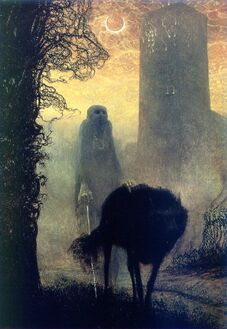 By M.P. Pellicer | Stranger Than Fiction Stories Are the stories about these cursed paintings real or just urban tales? 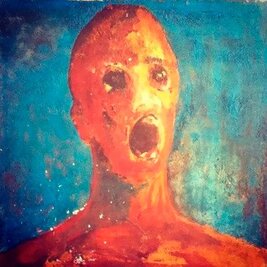 The Anguished Man comes from an unknown artist and is undated The Anguished Man comes from an unknown artist and is undated THE ANGUISHED MAN This story started out as a creepypasta. The painting was allegedly produced by an unknown artist, where he mixed his blood into the paint, and after finishing the portrait committed suicide. Sean Robinson inherited the piece from his grandmother who believed it was cursed, and told him the story of the origins of the painting. Like other stories of haunted portraits, once it was hung up, there were sightings of shadowy figures, inarticulate whispers and crying. Robinson who lives in Cumbria, U.K. uploaded videos in 2010 of the strange happenings in his home. He heard scrapings in the basement where the painting was stored, and fog appeared at the top of his stairs. Once he saw the figure of a man. Others who viewed the painting experienced nausea and nosebleeds. In 2016, rights were acquired to make a film based on the painting. 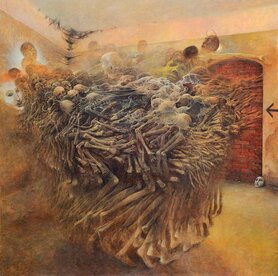 One of several untitled works by Zszislaw Beksinski One of several untitled works by Zszislaw Beksinski UNTITLED Zdzislaw Beksinski (1929-2005), is a Polish artist who did not title any of his paintings. He suffered from OCD which made him resistant to travel and he referred to his condition as "neurotic diarrhea." He studied architecture, but had no formal training as an artist. From the 1960s to the 1980s he created disturbing images, "showing a gloomy, surrealistic environment with detailed scenes of death, decay, landscapes filled with skeletons, deformed figures and deserts." He said that he didn't know the meaning of his work and was not interested in interpreting them, which is why he refused to provide titles for them. Beksinski's wife Zoila died in 1998, and a year later on Christmas Eve, 1999, he discovered his son Tomasz's body who committed suicide by a drug overdose. In 2005, Beksinski was killed after being stabbed 17 times. The perpetrator was the son of his longtime caretaker and friend, who was sentenced to 25 years in prison along with an accomplice to five years. The crime was spurred on when Beksinski refused to lend the perpetrator $100. There is a belief by some, that anyone who looks at the paintings for a longer time will soon die. 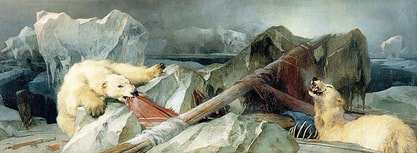 Man Proposes, God Disposes by Edwin Landseer c.1864 Man Proposes, God Disposes by Edwin Landseer c.1864 MAN PROPOSES, GOD DISPOSES This painting dates to 1864, in which the artist interprets what happened to Sir John Franklin's expedition which disappeared in the Arctic in 1845. It is housed at the Royal Holloway, University of London. During exam season it is covered by a Union flag, because the rumor is that in the 1970s a student committed suicide after staring at the painting. His note read, "the polar bears made me do it." Others comment the painting makes them feel uneasy. The artist is Edwin Landseer who gave a grim outcome to the expedition sent out to explore the Northwest Passage with the two ships, HMS Erebus and HMS Terror. Even though they were provisioned with food for several years, they were never heard from again. Search parties were sent out and Captain John Rae was given hints of sightings by the Inuit. He found some bodies on King William Island, and there were reports of possible cannibalism by the survivors. In 1869, another expedition found the remains of two sailors from the Erebus on King William Island. The painting was sold at auction in 1881 to Thomas Holloway. The myth attached to viewing the painting dates back to at least the 1920s or 1930s, which was that anyone sitting in front of the painting before taking an exam would fail it. The suicide of the unfortunate student has never been verified. 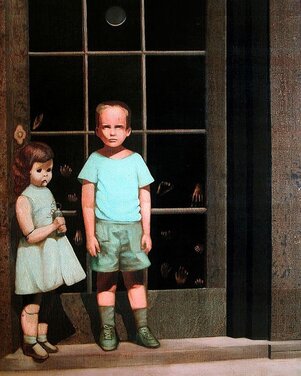 The Hands Resist Him by Bill Stoneham c.1974 The Hands Resist Him by Bill Stoneham c.1974 THE HANDS RESIST HIM Bill Stoneham produced the piece in 1974, at a time when his first wife Rhoann had written a poem titled Hands Resist Him. It was about her husband's experience of being adopted and never knowing his biological parents. He was adopted when he was 9 month old from an orphanage in Massachusetts. The painting did not gain notoriety until 2000, when it was placed on eBay as a haunted item. Stoneham said the boy in the painting is based on a photograph of himself at age five when he was living in Chicago. The doll was a female playmate who posed in the picture with him. The doorway in the painting demarks the separation between the waking world and the world of fantasy and impossibilities. The life size doll next to him is a guide. It was first shown at Feingarten Gallery in Beverly, Hills during the 1970s. The piece was bought by John Marley (1907-1984) who played Jack Woltz in The Godfather. A California couple found the painting at the site of an old brewery turned into an art space. Where it was during those years after it was sold to Marley, and why it was left where it was remains a mystery. The couple who put it up for sale on eBay described that it had a curse on it. Besides the description they included photographs where the doll was threatening the boy with a gun she was holding, which is when he attempted to leave the painting. There was a disclaimer to release the seller from liability once it was purchased. The listing read: At the time we wondered a little why a seemingly perfectly fine painting would be discarded like that (today we don't!!!). One morning our 4 and 1/2 year old daughters claimed that the children in the picture were fighting, and coming into the room during the night. 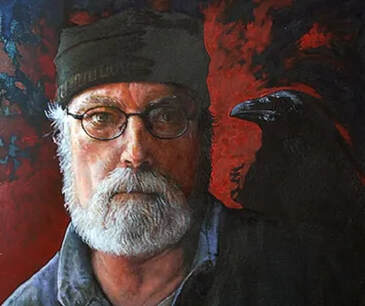 Bill Stoneham, self portrait (Source - Stoneham Studios) Bill Stoneham, self portrait (Source - Stoneham Studios) The painting received 30 bids and sold for $1,025 to Perception Gallery. Many who had looked at the painting while it was up for sale had unpleasant experiences. According to the Spokesman-Review, "Another reported that he became ill while viewing the painting and had to burn white sage to cleanse his house afterward. Another reported ‘blackout/mind control experiences'." After receiving 30,000 hits on the listing, before the auction was finalized, the sellers backtracked and wrote: "There are no ghosts in this world, no supernatural powers, this is just a painting and most of these things have an explanation, in this case, probably a fluke light effect." Perception Gallery contacted Stoneham and told him the story of the sale of the painting on eBay. He was unaware of the stories, but did relate the death Between 1978 and 1984, of three of the men closest to The Hands Resist Him. In February, 1978, Henry Seldis the LA Times Art Critic was found dead in his apartment, which was listed by police as a suicide. He was suffering from depression due to a divorce, and had tried to take an overdose of pills in September, 1977 during a first suicide attempt. In 1981, Charles Feingarten died from cancer at age 60. John Marley died in 1984, following open heart surgery. He was 77 years old. In 2004, Stoneham was commissioned to paint a sequel which was titled Resistance at the Threshold which was completed in 2012. He then produced a prequel, titled The Hands Invent Him. The Haunted Museum acquired the prequel painting in 2017. In 2021, Stoneham created the final painting called What Remains.  Replica of the Love Letters Replica of the Love Letters REPLICA OF THE LOVE LETTERS This painting is haunted by association. It hangs on the fifth floor of the Driskill Hotel in Austin, Texas, where Samantha Houston, 4, died when she fell from a flight of steps where she was playing with a leather ball. The hotel had just opened the year before. The painting is said to look like the unfortunate Samantha, and people who stay at the hotel claim the girl's expression changes. Others have seen the phantom of the little girl playing ball around it. Her father was Senator Temple Houston, and her grandfather was General Sam Houston. Her sister Louise age 2, died the same year from cholera infantum, and was buried in the same Mobeetie Cemetery as Samantha. In 1897, the couple lost another baby that was one month old. The painting titled Replica of Love Letters was produced by Richard King from an original painted by Charles Trevor Garland (1866-1906) a British artist. People who have viewed it, not only the one in the hotel but replicas report nausea and uneasy feelings around it that they cannot account for, since the subject is so innocuous. 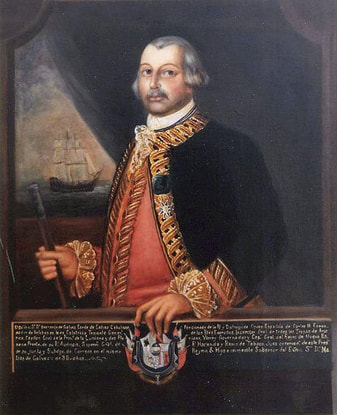 Bernardo Vicente de Gálvez y Madrid, 1st Count of Gálvez (1746 – 1786) Bernardo Vicente de Gálvez y Madrid, 1st Count of Gálvez (1746 – 1786) THE GHOST OF GALVEZ Bernardo Vicente de Gálvez y Madrid, 1st Count of Gálvez (1746 – 1786) served as governor of Spanish Louisiana and Cuba. He was a soldier most of his life serving in Europe, the Americas and North Africa. He sided with the colonists when they fought the British during the Revolutionary War. He drove the British out of Florida's west coast. Galvez Day is a holiday in Pensacola, and Galveston, Texas, an island he never actually visited, is named in his honor. So how did this man end up haunting his portrait, which he himself commissioned in the 1780s? It hangs at the Grand Galvez Resort and Spa and guests report the eyes of the count follows them around, which could be a well known effect many artists employed, however there is something else which is quite strange. Those who take a picture, only get a blurry image, that is unless they ask permission first. Perhaps it's not the painting, but the place itself. In 1900, the Great Galveston hurricane made landfall. It ravaged the island, and swept away the St. Mary's Orphan Asylum. Only 3 children out of 93 orphans and 10 nuns survived. Their bodies were not recovered and it's believed some of their remains were buried under the debris of the orphanage. It was on the site of where St. Mary's once stood that the Grand Galvez opened its doors in 1911, after 10 years of construction and at the cost of $1 million dollars. 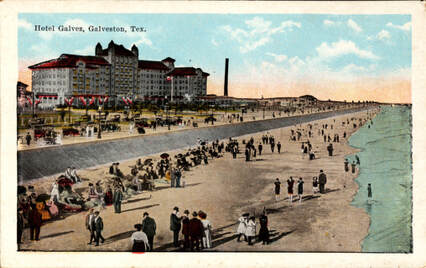 Hotel Galvez, postcard Hotel Galvez, postcard Another hurricane roared into Galveston in 1915, killing 275 persons, but the hotel unlike the orphanage survived. A speakeasy operated there during Prohibition, and during the years of WWII it became a US Coast Guard station, devoid of tourists of course. Reports of unusual phenomena come from all around the 226 room structure, but Room 501 is connected to the Ghost Bride. The story is that a young woman would look out to sea from a hatch on the roof, waiting for her lover who was her sailor to return. News reached her he had been lost at sea with the ship. She hung herself in the west turret of the hotel. The reason for her haunting the room is evident. A little girl with a ball is seen in the lower floors, and a man is sighted in the hotel laundry. Children's laughter is heard near one of the bathrooms and the Music Hall. A ghostly maid has been seen, and a man who walks into a closed door. No doubt the source of these phantoms is a cast of hundreds, considering how long the hotel has been there. But there is something that occurred only three years after the Galvez Hotel opened its doors, that could account for an unhappy spirit. 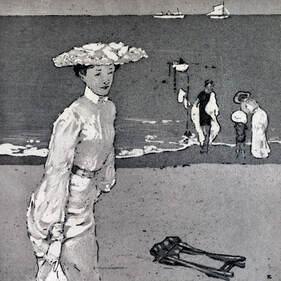 Woman in White on the Beach Woman in White on the Beach In 1914, the body of a pretty girl was found shot to deah on Galveston Beach near the hotel. The suicide theory didn't hold water since there were no powder burns at the head wound, and no weapon was discovered. There were no signs of a struggle. Residents on the boulevard didn't hear gunfire or an outcry. She didn't have any identifying marks on her clothing, which were of fine texture. She didn't have any jewelry on her. She was discovered by an employee of the Galvez Hotel who found the body lying partially covered with sand from the high tide. Physicians who examined the body found the bullet had passed directly through, and would have killed her instantly. If there were bloodstains at the scene, they were washed away by the waves. The police suspected she was the daughter of a wealthy family, and she was lured to the spot and robbed of her jewelry and money. The woman was wearing an expensive white dress of sheer material, new tan shoes, and silk stocking to match. Nearby was her Panama hat and one glove. She had long, luxuriant black hair, gray eyes and she had no makeup on her face. She was about 5'5" tall. Later in the afternoon a miniature figure of the Virgin Mary was found near the body. The police were following up to see if she attended services at St. Mary's Cathedral. On July 22, 1914, the newspapers announced it was thought the woman was Mrs. George Hopper of Cleburne, Texas, which turned out to be wrong. The police discovered that the night of the murder they were several quarrels along the beach. A man and woman drove up to the resort. The man made accommodations, but the woman refused to leave the car. Then a violent quarrel started, until the couple drove away. Finally on July 24, the woman was identified by her cousins as Elvira Davis of San Antonio. She was the private secretary and librarian to capitalist George W. Brackenridge. 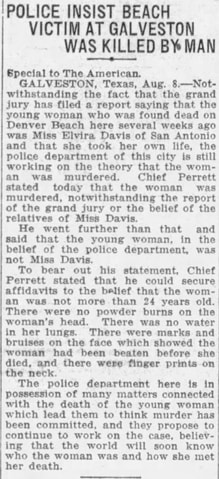 Was Elvira Davis murdered? c.1914 (Source - The Austin American) Was Elvira Davis murdered? c.1914 (Source - The Austin American) One theory the police held was that considering she was scantily clad, and she was not wearing underskirts or petticoats, she was murdered in the hotel, dressed and brought to the beach. Breckenridge said he had received a business letter from the girl the week before, but there was no mention of ending her life, which later he disavowed. Another rumor was that she feared she would be struck down by cancer, which had caused the death of a sister. She also suffered from chronic rheumatism. The police also theorized that she was a member of an automobile party who rode to the beach where she was killed for some unknown reason. The coroner rendered a verdicts of "Came to her death by a bullet fired by some person or person unknown." Two weeks later Governor Colquitt offered a reward of $200 for the arrest and conviction of the murder or murderess. Despite the coroner's verdict, by the first week of August the grand jury held that the victim killed herself. However the police insisted that she was killed by a man. It was never explained why there was a change in the reason for her death. The police chief said they even doubted that the identity of the woman was Miss Davis. Chief Perrett stated he could secure affidavits that the woman was not more than 24 years old, and Elvira Davis was 44 years old. This and the fact there were no powder burns on her head, and there was no water in her lungs threw into doubt she died by her own hand. There were marks and bruises on her face which indicated she had been beaten before she died. She also had fingerprints on the neck. Contradicting she was killed by someone else was a farewell letter sent to her employer, and a telegram to Dr. Schaefer, her friend. She told them that hereditary rheumatism was overcoming her, and she had no one depending on her. She didn't want to become helpless and dependent upon others. Her parents and four of her siblings were all dead already. So did Elvira commit suicide or was she murdered? Was it even the body of Elvira? Four years before her death she was living in Benicia, California. After the inquest the search for the killer died away despite the police's belief she met with foul play. Perhaps she is one of those that doesn't lie quiet in her grave, and haunts the Galvez Hotel.
0 Comments
Your comment will be posted after it is approved.
Leave a Reply. |
Stranger Than Fiction StoriesM.P. PellicerAuthor, Narrator and Producer Archives
July 2024
Categories
All
|
Stories of the Supernatural
- Stories of the Supernatural
- Miami Ghost Chronicles
- M.P. Pellicer | Author
- Stranger Than Fiction Stories
- Eerie News
- Supernatural Storytime
-
Astrology Today
- Tarot
- Horoscope
- Zodiac
-
Haunted Places
- Animal Hauntings
- Belleview Biltmore Hotel
- Bobby Mackey's Honky Tonk
- Brookdale Lodge
- Chacachacare Island
- Coral Castle
- Drayton Hall Plantation
- Jonathan Dickinson State Park
- Kreischer Mansion
- Miami Biltmore Hotel
- Miami Forgotten Properties
- Myrtles Plantation
- Pinewood Cemetery
- Rolling Hills Asylum
- St. Ann's Retreat
- Stranahan Cromartie House
- The Devil Tree
- Trans-Allegheny Lunatic Asylum
- West Virginia Penitentiary
- Paranormal Podcasts
"When misguided public opinion honors what is despicable and despises what is honorable, punishes virtue and rewards vice, encourages what is harmful and discourages what is useful, applauds falsehood and smothers truth under indifference or insult, a nation turns its back on progress and can be restored only by the terrible lessons of catastrophe."
- Frederic Bastiat
- Frederic Bastiat

Copyright © 2009-2024 Eleventh Hour LLC. All Rights Reserved ®
DISCLAIMER
DISCLAIMER
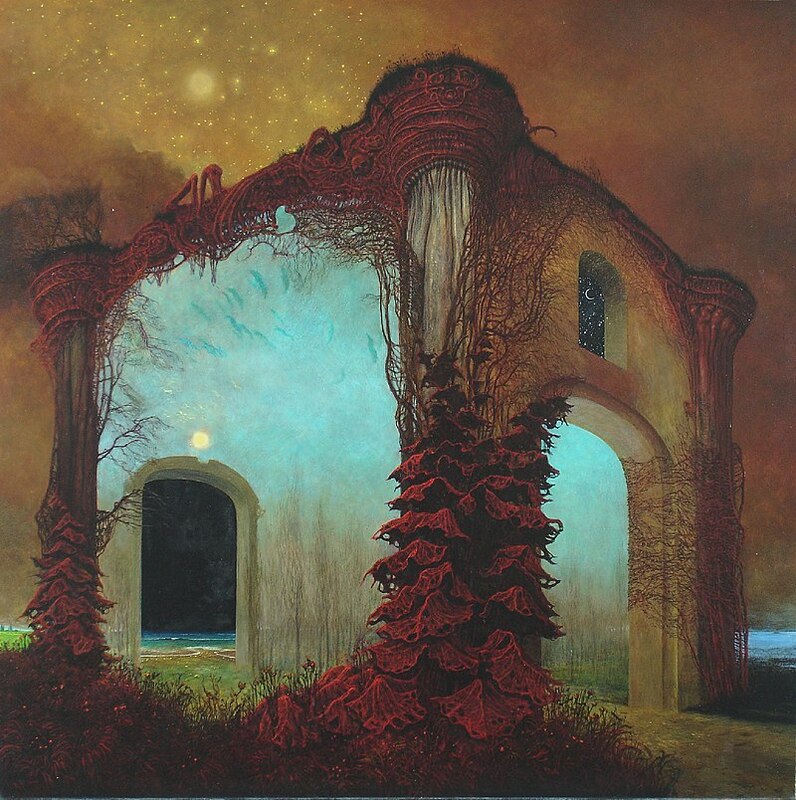
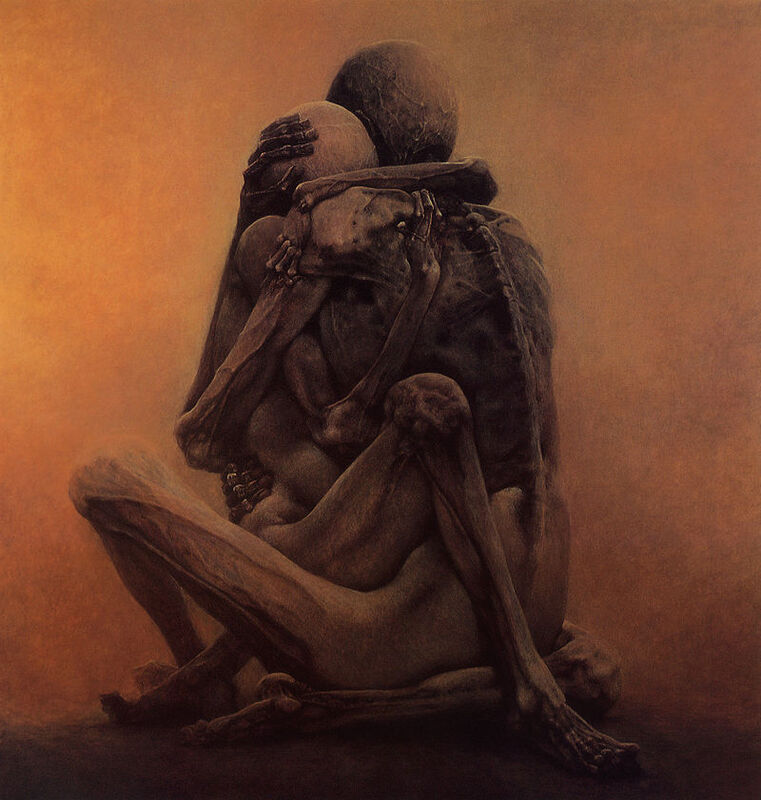
 RSS Feed
RSS Feed
















